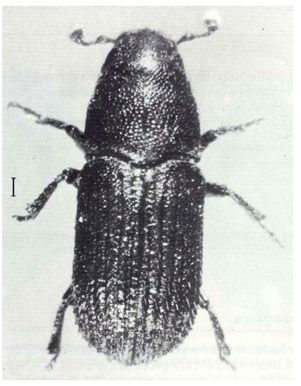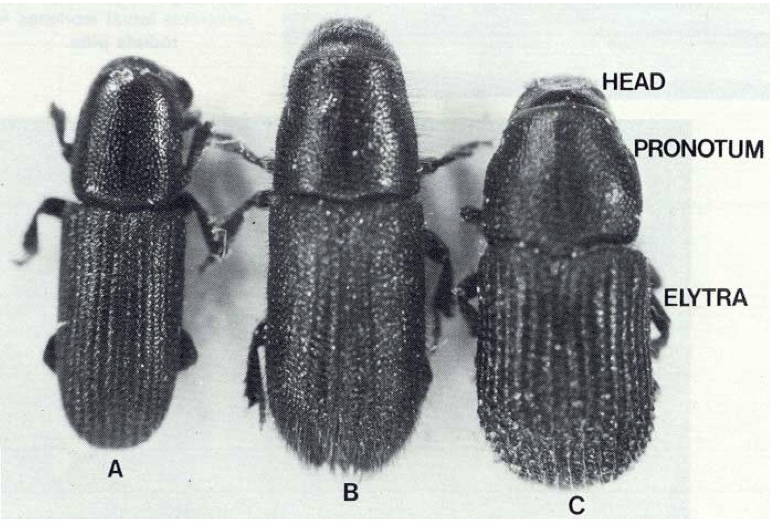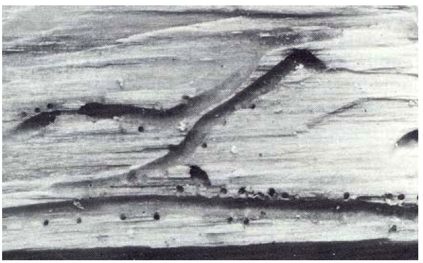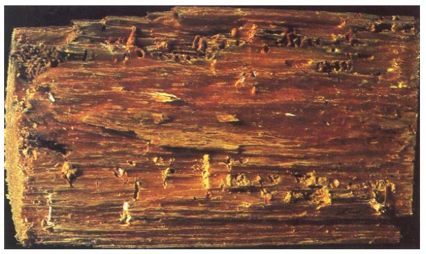PESTS AND DISEASES OF FORESTRY IN NEW ZEALAND
Pachycotes peregrinus, a native borer
Scion is the leading provider of forest-related knowledge in New Zealand
Formerly known as the Forest Research Institute, Scion has been a leader in research relating to forest health for over 50 years. The Rotorua-based Crown Research Institute continues to provide science that will protect all forests from damage caused by insect pests, pathogens and weeds. The information presented below arises from these research activities.
Forest and Timber Insects in New Zealand No. 19: Pachycotes peregrinus.
Revised 2009
Based on J. Bain (1977)
Insect: Pachycotes peregrinus (Chapuis) (Coleoptera: Scolytidae)

Fig. 1 - Pachycotes peregrinus adult.
Type of injury
Pachycotes peregrinus is a borer in moist logs and slow-seasoning forest produce such as posts and poles. Freshly sawn timber may be attacked, especially between the boards, when stored under damp conditions. The first evidence of attack is the presence of circular holes about 2.5 mm in diameter through which white frass (bore dust) is ejected. The entry and brood tunnels of the adult are kept free of frass, and in fresh logs they are found only in the outermost sapwood. The larval tunnels vary in diameter according to the size of the larva and are lined with clay-like frass. Material such as logs in contact with the ground which retain a high moisture content can be repeatedly re-infested, and the wood becomes riddled with adult and larval tunnels.
Hosts
All exotic softwoods of economic importance are attacked. Native softwoods, including Prumnopitys ferruginea (miro), P. taxifolia (matai), Dacrycarpus dacrydioides (kahikatea), Dacrydium cupressinum (rimu), Agathis australis (kauri), and Phyllocladus alpinus (mountain toatoa), are also utilised.
Distribution
This native beetle occurs throughout New Zealand except in the drier pine forests, e.g. Balmoral and Eyrewell in Canterbury.
Economic importance
Logs stockpiled in the forest near breeding sites may be attacked but damage is not usually significant because the initial galleries are mainly in the outer sapwood and are removed with the slab during sawing. The larvae die during seasoning but timber sawn from infested material may be degraded by the sapstain fungi associated with the beetles. Freshly sawn timber may be attacked if stored under damp conditions. Pachycotes peregrinus is not often present in export logs, but if it is then export is prohibited.
Description, life history, and habits
The adult (Fig. 1), which is about 4.7 mm long, resembles Hylastes ater but is relatively stouter and has a slightly more humped profile when viewed from the side. The pronotum is dull and not shining as in H.ater. Both H. ater and P. peregrinus beetles may be confused with Hylurgus ligniperda, but the latter is larger (about 6 mm long) and has a hairy appearance. The three beetles are shown in Fig.2. The larvae of all three species are white C-shaped, legless grubs with light yellowish-brown head capsules. Pachycotes peregrinus ejects granular white frass from the entry tunnel but the frass of H. ater and H. ligniperda is reddish-brown. Pachycotes peregrinus bores in the wood but H. ater and H. ligniperda tunnels are made in the bark, or just under it, and this accounts for the different colours of frass. Platypus apicalis, a native pinhole borer, also makes white frass but this consists of fine strands of wood and has a fibrous rather than granular appearance.

Fig. 2 - Three beetles which may be mistaken for each other: (A) Hylastes ater, (B) Hylurgus ligniperda, (C) Pachycotes peregrinus . Note differences in shape of rear edge of pronotum.
Adult P. peregrinus emerge during the summer months and attack logs, stumps, etc. They enter wood at right angles to the grain and construct brood tunnels parallel with the grain. The entry tunnel is usually about 24 mm long and the brood tunnel about 150-200 mm. The female lays eggs into small notches cut in the sides of the brood tunnel. The larvae, starting from these notches, bore at right angles to the brood tunnel but usually soon curve around (Fig. 3). The larval tunnels are widened as the larvae grow, the larvae working back and forth over their initial paths and lining the tunnels with clay-like frass. The larval tunnelling pattern soon becomes confused and tunnels extend in all directions (Fig. 4). The duration of the larval stage is not known exactly but very likely it is almost two years. The larvae pupate anywhere along the length of the tunnels and the new adults cut individual exits to the surface or emerge through earlier workings.

Fig. 3 - Pachycotes peregrinus brood tunnels in which eggs were laid.
The round holes are tunnels made by larvae boring at right angles and then curving around.

Fig. 4 - Pachycotes peregrinus larval workings in radiata pine.
Control
Prompt extraction and sawing of logs after felling will minimise defects in sawn timber.
Bibliography
Bain J. 1977: Pachycotes peregrinus (Chapuis) (Coleoptera: Scolytidae). New Zealand Forest
Service, Forest and Timber Insects in New Zealand No. 19.
This information is intended for general interest only. It is not intended to be a substitute for specific specialist advice on any matter and should not be relied on for that purpose. Scion will not be liable for any direct, indirect, incidental, special, consequential or exemplary damages, loss of profits, or any other intangible losses that result from using the information provided on this site.
(Scion is the trading name of the New Zealand Forest Research Institute Limited.)



